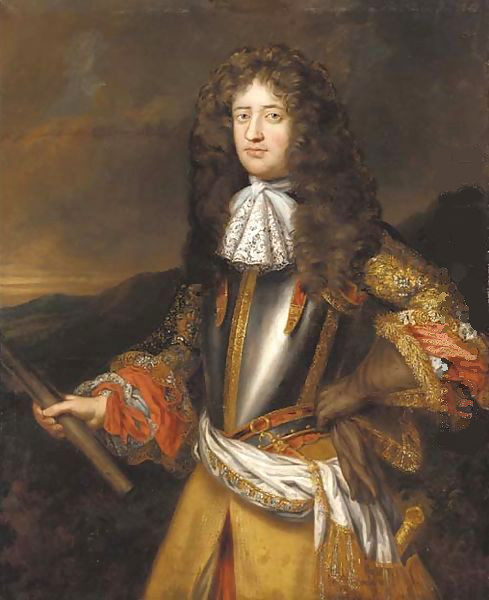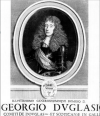George Douglas, 1st Earl of Dumbarton

Major-General George Douglas, 1st Earl of Dumbarton (b. 1635, d. 20 March 1691/92) was the son of William
Douglas, 1st Marquess of Douglas
and Mary Gordon. He married Anne Wheatley, daughter of Robert Wheatley.
He gained the rank of Colonel in 1665 in the service of the 1st Foot.
He was created 1st Lord Douglas of Ettrick [Scotland] on 9
March 1674/75. He was created 1st Earl of Dunbarton [Scotland]
on 9 March 1674/75.
He was commander of the Scottish army
which defeated pro-Monmouth forces under the Earl of Argyll in
1685. (See:
Argyll's Rebellion)
He
was a Gentleman of the
Bedchamber to James II (VII in Scotland).
George Douglas kept a pack of terriers from Scotland that was
so tough he called them the “Diehard Pack”. He later went on to
name his favourite regiment, The Royal Scots, “Dumbarton’s
Diehards” after his dogs. The nickname ‘Diehard’ has stuck with
the Scottish Terrier to this day.
On February 6, 1685, Charles II died, and the succession to
the throne of a Catholic King in James VII/II brought to a head
both the discontents at home and the plots of exiles abroad. The
militia was called out; a force of regulars was assembled under
the Earl of Dumbarton, the new Scottish Commander-in-Chief —
that Lord George Douglas who had commanded and given his name to
the Royal Scots, and who is commemorated in their regimental
march of “Dumbarton’s Drums.”
Douglas—a good soldier who was
afterwards (after being appointed Scottish Commander-in-Chief) to win fame
in William’s service at Limerick, but a man of a jealous and irascible
temper—had already turned his eyes to the rising sun.
earl_dumbarton_thistle_small.jpg) Click
to enlarge Click
to enlarge
He was invested as a Knight, Order of the Thistle (K.T.) in 1687.
He gained the rank of Major-General in the service of the French Army.
When King James VII/II fled to France, he was joined in exile by
the Earl of Dumbarton. In 1660, George was injured in a duel with the
duc de Normandie. The future James II of England was made "Duke of
Normandy" by King Louis XIV on 31st December 1660, a few months after the
restoration of his brother Charles II to the throne of England and Ireland.
The latter being already Duke of Normandy, having also been proclaimed king
in Jersey in 1649. The fact of granting this same title to James II - in
reference to the continental Normandy - undoubtedly constituted a political
gesture on the part of the Sun King. George Douglas, 1st Earl of Dumbarton died
at St Germain-en-Laye, a royal palace being used by James II, and was buried
at the Abbey of Saint-Germain-des-Prés, amongst other members of his family.
Child of Major-General George Douglas,
1st Earl of Dumbarton and Anne Wheatley:
It is suggested that George Douglas is the ancestor of the Douglas
family of Montréal-en-Bugey,
in France. However, they were in possession by at least 1622.
Historical note:
The execution of the Mauchline martyrs initiated the most violent period
of the Killing Times.
Their deaths are first recorded in Alexander Shields’ A Short Memorial
(1690):
‘Item, The said [John Graham of] Claverhouse, together with the Earl of
Dumbarton, and Liev: Gen: Dowglas, caused Peter Gillis, John Bryce, Thomas
Young, (who was taken by the Laird of Lee,) William Fiddison, and John
Buiening, to be put to Death upon a Gibbet, without Legal Tryal or Sentence,
suffering them neither to have a Bible, nor to preay before they died, at
Mauchlin[e], anno 1685.’
The most confusing name listed by Shields is that of General George Douglas,
1st earl of Dumbarton. On 6 May, the traditional date for the executions in
Mauchline, Dumbarton was in London. Why is his name attached to the
executions? The earl of Dumbarton was the younger brother of William
Douglas, duke of Hamilton. Alongside his men, Dumbarton’s Regiment of Foot
which was recruited in Scotland, he fought for Louis XIV and rose to become
a Marechaux De Camp in the French Army. The song ‘Dumbarton’s Drums’ is
based on the Jacobite sympathies of the regiment.
In the 1670s, Dumbarton and the regiment returned to the King’s service and
in May 1685 he was sent to Scotland to assume overall command of Scottish
forces that would face the earl of
Argyll’s rising. As James King Hewison pointed out a century ago, the
involvement of the earl of Dumbarton in any trial on 6 May is impossible, as
the newly-commissioned earl was expected to arrive from London on 13 May.
Hewison’s solution was to move the date of the executions back to 16 May.
However, it is more likely that Dumbarton was listed because he was the
later commander-in-chief of the forces which were responsible for the
Mauchline executions. Dumbarton was a high-profile Jacobite. At the
Revolution he joined James VII in France. He died in exile in 1692 and is
buried in the Abbey of St Germain des Prés. (Hewison, Covenanters, II, 478.)
 Thought
to be George, Earl of Dumbarton. This 17th century print, a
revolutionary seizure now in Museum of Fine Arts in Rennes, France Thought
to be George, Earl of Dumbarton. This 17th century print, a
revolutionary seizure now in Museum of Fine Arts in Rennes, France
Note:
In May 2018, Prince Harry and his wife, Meghan, were created Earl and
Countess of Dumbarton on the occasion of their marriage.
See also:
• Dumbarton's
Drums
|
|


